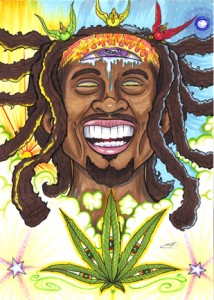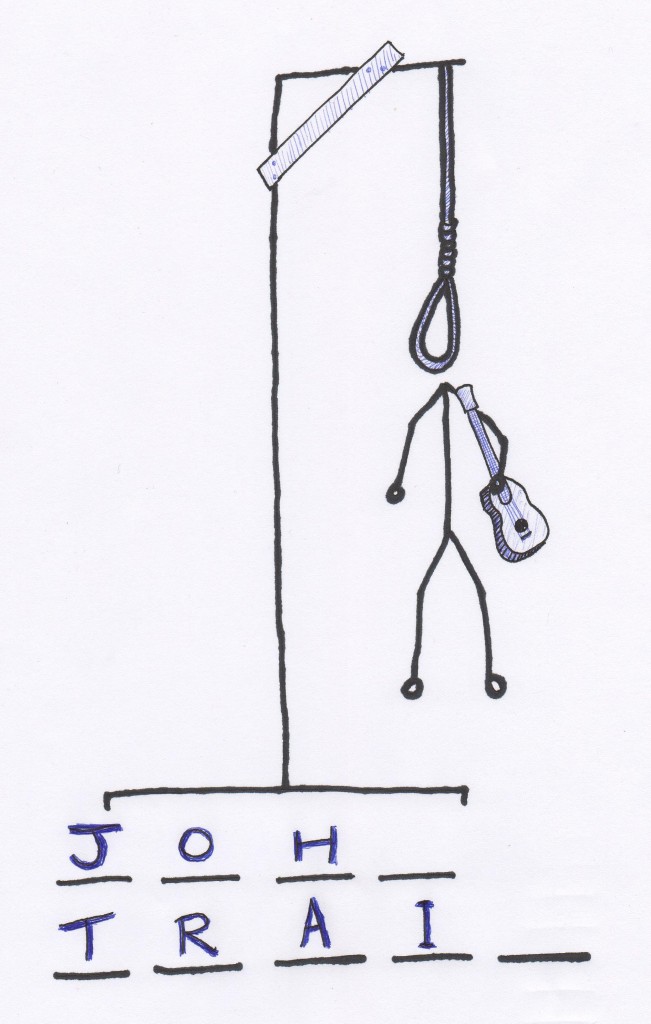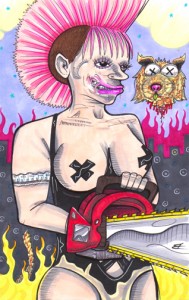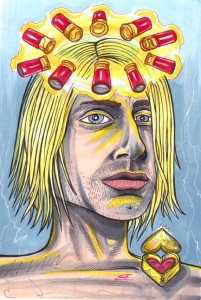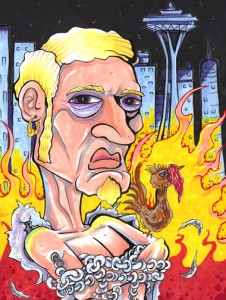Bob Marley shined a ray of hope upon the starved and battered denizens of the Third World with his soothing reggae rhythms. The singer rose up from the brutal Jamaican ghetto to emerge on the international music scene as a charismatic voice of conscience, shedding light on the bitter legacy of European colonialism to the shame of well-fed “baldheads.” He sang an apocalyptic song of freedom, tapping Rasta prophecies that promised the return of Africans to their homeland, Zion, and the total destruction of decadent Western society, or Babylon. As the tumultuous 1970s drew to a close, Marley and his fellow Rastafari were certain that the end was nigh.
Bob Marley’s world ended in a Miami hospital bed on May 11, 1981, while the First World’s marketing gurus captured and framed his image in ganja green, blood red, and merchandising gold. Despite the best intentions of international charities and the impassioned diatribes of pot-smoking college students, thirty years after his passing the Third World continues to groan under the weight of commercial exploitation and crushing poverty. Perhaps Jah smoked one spliff too many and forgot all about Armageddon.
If Heaven is peace and plenty, then sweltering Caribbean ghettos are Hell on earth. Even sheltered tourists can’t help but notice the desperation and violence that seethes beyond the putting green. Jamaica’s African slaves were officially set free in 1838, which meant that masses of peasants had no jobs and the white aristocracy had little vested interest in providing adequate food or shelter. The 20th century saw a few enterprising individuals—mostly foreign investors—turning a profit by mining bauxite and growing bananas, while the rest of the island’s 2.5 million inhabitants were left grasping for dreams and submachine guns.
Bob Marley was born in the tiny Jamaican village of Nine Mile in 1945, the son of a poor, earth-hued woman who nurtured him to his dying day and an aging, lily-white seaman who set sail when Bob was a baby. The boy grew up in Trench Town, a shanty-strewn slum of Kingston, the nation’s capital. According to Timothy White’s romantic biography, Catch a Fire, young Marley was a respected streetfighter—his favorite jab was “Me got de handle, focker, yuh gon’ get de blade”—and soccer-playing rude boy who could also belt out a captivating tune.
Knowing that idle hands are ol’ Screwface’s plaything, Bob’s mother put him to work as a welder, but after a stray steel splinter lodged itself into his eye, music became his life. Though his earliest songs were dancy pop tunes, by the late 60s Bob Marley and the Wailers would shed their sharp suits and ties for the Rasta-inspired reggae style that would make them legends.
When he was a boy, the dusty, dreadlocked mendicants who wandered barefoot from the Dungle to the jungle struck fear in Bob Marley’s heart. At that time, the cult of Rastafari was still an obscure offshoot of Marcus Garvey’s militant “back to Africa” movement which gathered only the most austere adherents, but by the 60s much of Jamaican society embraced rebellious Rasta mysticism as the symbolic antithesis of the white ruling class they despised.
The sect’s belief system is an amalgamation of biblical prophecy and Afrocentrism, taking its name from Ras Tafari, who was crowned Ethiopia’s emperor in 1930 and thereafter known as Haile Selassie I. This was heralded by many of Marcus Garvey’s followers as a fulfillment of prophecy, citing Psalm 68:31: “Princes shall come out of Egypt; Ethiopia shall soon stretch out her hands unto God.” The Ethiopian press called Selassie “King of Kings” and the “Lion of Judah,” which fueled the fire.
Rastafarians came to believe that His Majesty Haile Selassie would gather the lost tribes of Africa to the mother continent and establish God’s Kingdom on earth. Many believed him to be God incarnate. When the Emperor visited Jamaica in April 1966, over 100,000 fervent believers flocked to greet him on the tarmac, hoping that the divine king would finally liberate them from Babylon and bring them home. The Emperor was dumbfounded by this bizarre reception. While Selassie never denied his divinity, he suggested that the people of Jamaica pursue freedom on their own island rather than pour into Ethiopia.
Bob got married that same year, and his wife, Rita, witnessed Haile Selassie’s procession through Kingston. She was sure that the Emperor looked directly into her eyes and waved his hand—which bore a stigmata. It was not long before she became a devout Rasta, bringing the word back home to her husband.
Bob was not an instant convert. He had always been inspired by moralistic proverbs and enjoyed a nice puff of reefer now and again, but it was not until he met Mortimo Planno in 1967, the only Rasta elder to have direct contact with Haile Selassie, that Marley came to follow the Rasta path. During a heavy smoking session, Bob told Planno about a strange dream in which a khaki-dressed man gave him a ring with a black stone. Planno covered all angles, telling Bob the dream was a sign that he would either grow spiritually or “ketch a fire.” Preferring the former possibility, Bob began to grow out his dreads and “reason” with the Rastas.
During a disastrous, if serendipitous international tour in 1972, the Wailers found themselves stranded in London, where they met Chris Blackwell, founder of the rock label Island Records. Blackwell would go on to provide the capital and promotion behind the group’s phenomenal success among rock n’ roll fans, bringing reggae into the mainstream. After the remarkable critical reception of the back-to-back albums Catch a Fire and Burnin’ in 1973, Bob Marley and the Wailers became the Rastafari’s representative to the world.
Rastafari’s reputation for marijuana and sexual license has often overshadowed the rigid discipline of the sect. The commandments of God, or “Jah,” are to be followed rigorously. Drawing on Old Testament law, Rastas abstain from eating pork and shellfish—or any meat for that matter. Even salt is considered unclean. Their dreadlocks are inspired by the biblical decree that men are not to take a razor to their heads.
Of course, the cultivation, sale, and constant smoking of ganja is a central activity for Rastafarians. The Bible is regarded as the word of truth, but Rastas also hold that it has been corrupted by the editorial work of the wicked white man. Therefore their biblical study is to be assisted by inner visions, and there is nothing like a fat joint to inspire a vivid imagination.
The Rasta community generally survives on the squatter fringe of society. Material excesses are shunned, as well as the unnatural technologies of their white oppressors. Both capitalism and communism are generally held in contempt, the former for its exploitation of the People of Jah, the latter for its condemnation of religion. Despite their abiding faith that Jah will soon inaugurate an age of peace, Rastafarians are willing to defend their property, family, and honor by any means necessary. Even those Jamaicans who find the Rasta beliefs to be nonsensical will generally show dreads the respect that any potentially violent earthly power commands.
In 1975 Haile Selassie was deposed—and most likely assassinated—by Marxist revolutionaries in Ethiopia, yet many Rastas refused to believe that His Majesty had actually died. How could God die? It had to be more lies from the Babylon press. It was just another sign of immanent Armageddon, and they would wait patiently for the return of their king.
The absolute kingship of Haile Selassie notwithstanding, Rastafari generally eschew all earthly hierarchies among men. However, women are not included in important activities—eg. the smoking of the sacred chillum—particularly during their menstrual cycle, when they are completely segregated from the men. Traditionally, Rasta women are there to have sex, bear children, cook meals, perform household chores, and keep their mouths shut unless asked for an opinion. They are to maintain the highest standards of modesty, wearing no makeup but “the beaded gleam on their brows and the dust on their necks, their only fragrance that of perspiration.” You know, a good woman.
Rita Marley was such a woman. While Bob shined in the spotlight, Rita sang backup. While Bob took countless beautiful lovers to bed—including Miss World ’76—Rita waited faithfully for her man to come home (most of the time, anyway.) And when Bob brought his numerous illegitimate children home for a visit, Rita bestowed her blessings, as Rasta women consider themselves to be mothers to all children. She even took a bullet for her husband.
1976 was a turbulent year for Bob Marley. He was riding the recent international success of his “No Woman, No Cry” single, and had acquired a luxurious house in a wealthy neighborhood in uptown Kingston. To the chagrin of his wife and fellow ghetto Rastas, Bob was drawn into the fold of the Twelve Tribes of Israel, an elitist splinter sect of the Rasta movement led by the charismatic Prophet Gad.
Bob’s close friend Skilly Cole became a Twelve Tribes disciple as well. The former professional soccer player was a man of many talents. Aside from terrorizing and occasionally beating Jamaican DJs to get Bob Marley records on the air (which he admitted in court,) Skilly was also involved with a crime syndicate known as the Concrete Jungle. One of their scams was to rig horse races by kidnapping and threatening jockeys, but when the deal went sour, Skilly’s gangster associates came after Bob. The thugs extorted Bob for Skilly’s debt, to be paid off two thousand dollars a day.
To top it off, Kingston was in the throes of a political frenzy. Jamaican elections were often marred by shootouts between the hired thugs of both major political parties—the conservative Jamaica Labor Party and the socialist People’s National Party—but the 1976 elections were particularly riotous. With the global oil crisis crippling the economy, the streets stirred with discontent and the possibility of popular uprising. Prime minister Michael Manley sent an envoy to Bob’s house to ask him to perform at the state-sponsored Smile Jamaica concert before the December election in an attempt to calm the agitated public. Bob agreed, despite the threat of becoming entangled in the political violence.
One week before the concert, the PNP provided 24-hour security at the Marley house. As a result, the Concrete Jungle’s money collector was repeatedly turned away. On December 3, two days before the Smile Jamaica concert, seven thugs descended upon Marley’s house with guns blazing. His manager, Don Taylor, was shot in the legs and spine. Rita was hit in the skull while running out of the house with Bob’s children, and one of the gunmen popped Bob in the chest, barely missing his heart. The shooters escaped before police arrived. Somehow no one was killed, and Marley played an extended set at Smile Jamaica, famously saying, “De people trying to make dis world worse aren’t taking a day off. How can I?”
There are no official confirmations of the assailants’ identities, but according to Timothy White’s biography they were brought to justice. Two were shot in the head. Two had their throats slit in the jungle, Rasta style. The remaining two went insane, wandering the streets muttering about flaming ghosts and snakes in their heads—one hung himself, and the other simply disappeared. Years later, manager Don Taylor—who also claimed that Marley had beat the shit out of him on multiple occasions after he took a bullet for Bob—testified that he had witnessed some of the men being tried and hung in a back alley by a lynch mob.
Bob disappeared for a month while things cooled off, emerging with the release of Exodus the following year, calling for repatriation in the face of persecution on the title track:
Walk, through the roads of creation
We’re the generation
Who trod through great tribulation
Exodus, movement of Jah people…
It was that year, 1977, that Bob met with Haile Selassie’s exiled successor, Crown Prince Asfa Wossen. The men talked for hours, but before they parted, Wossen presented Marley with a token of his esteem. It was the late Emperor Haile Selassie’s ring, bearing a black jewel and an image of the Lion of Judah, which Wossen slipped onto Marley’s index finger—just like in his dream. Marley was dumbfounded. His fate was sealed.
That same year, Bob Marley incurred a soccer injury on his toe, but the wound refused to heal. He was diagnosed with melanoma. Doctors advised amputation, but Marley refused, as such procedures were considered a bodily desecration by Rastafarians. He would put his faith in Jah and carry on.
For the next three years, Bob Marley released three brilliant albums, including his final revolutionary call to Jah’s people, Uprising. In 1978, he embarked on a sweeping Babylonian world tour of the US, Europe, Australia, and Japan. Jamaican expatriates in London, New York, and Miami were enthralled, as well as Aborigines in Australia and, oddly enough, rebellious Japanese youths.
That same year, Marley’s most telling statements came in an interview with Mumia Abu-Jamal, considered a political prisoner by the radical left after being convicted for murdering a white police officer. Their candid conversation is rarely mentioned in Marley’s glowing retrospectives. Incredulous Babylonians would never understand.
[translation here]
“Once you smoke herb, you all must think alike,” Marley explained to Abu-Jamal, “Now if you thinking alike, dat mean we ‘pon the same track. If we ‘pon the same track, that mean we gonna unite….
“Exodus means coming together…the movement of Afrika, of Black people. Exodus from Babylon, we’re in Babylon, and then a physical exodus to Home. But what we really a say is dat, we waan Black people to unite, with one another, seen?…
“Because, what [Haile Selassie] say is true. Until the philosophy that hold one people higher than the other one is no more, then if it continue, ya gwanna have war! When it done, problem over, seen?…
“Because Christ government shall rule the earth, ya know? And Christ is Rastafari! Over a period of time, people think, and hafta get over thinking that Christ was White. But Christ a Black mon! Just like the Bible tell ya, say Christ Black, Solomon, say him Black, Moses, tell ya, say him Black, Jeremiah, say him Black, Haile Selassie Black. So Christ no white. Christ Black, you know?…
“[The Church in] Rome is the enemy, you know? Rome is the enemy of the people. Dem is the Anti-Christ, and dem walk around and tell people dem a deal with Christ. But naturally, dem is Anti-Christ, for Christ is Haile Selassie…
“Capitalism and communism are finished. It Rasta now! The Blackmon way of life. That’s what we a say now dread. We a say: give the Blackmon fe him way of life now. Mek him show you how government run and how people care for people….
“Cause the white man not living good, you know. The China man naa live good, either. Why? Because the Blackmon is not united. Because the Blackmon, him are the cornerstone pon earth! When time him shaky, the whole earth shaky. You see? When him solid, everything solid. And it a long while since we have been solid….”
In April 1980, Bob Marley appeared at the Zimbabwe Independence Day ceremonies before returning to New York. He knew that his time was short. Though kept a secret from the public, the cancer had metastasized from his toe to his lungs, liver, and brain. That September he played two final shows in Madison Square Garden, but collapsed the next day while jogging with Skilly Cole in Central Park. He was rushed to the hospital after suffering a stroke, where he immediately began receiving radium treatments in the Cancer Center.
Marley clung to life with all of his might. He flew to Germany to receive the contraversial treatments of Dr. Josef Issels, whose “whole body” theory held that nutritional deficiencies and toxic impurities were responsible for cancer, but life was slipping away. En route to Jamaica, Marley was taken to the Cedars of Lebanon Hosptial in Miami, where he finally succumbed to the creeping illness on May 11, 1981.
The whole of the Third World and the fringes of the First wept at the death of their prophet. There was spiritual confusion. If Jah’s blessing bestows health and happiness, why had His tortured disciple died in such a fashion, his body eating itself whole, his sacred dreadlocks falling away?
Bob Marley’s body was interred in a tomb near his hometown after a dramatic state funeral. The Twelve Tribes of Israel were left reeling, but their Prophet Gad was sure of one thing. He wanted the Emperor’s black-stone ring bearing the Lion of Judah, and hectored Marley’s mother in her time of mourning. Bob Marley was his disciple, the Prophet Gad insisted, and by rights the precious ring was his. The End Times were upon the land, and Gad was chosen to lead Jah’s people.
“De ring gwan back from whence it came,” Marley’s mother told the so-called Prophet. “It back on His Majesty’s mighty hand. And yuh know neither de day nor de hour.”
Marley’s message of freedom has since spread to the ends of the earth. Cynical Westerners may mock the ridiculous and generally superficial manner in which Bob Marley’s Rastafarian way of life is adopted by white kids lacking their own racial identity, but the sense of collective suffering and redemptive hope that Marley’s music inspires in the poorest corners of the earth is mind-blowing. From Carribean shanty-towns to New York tenements to the most squalid African village, revolutionary reggae presents the glorious possibility that one day all of God’s children will be invited to the table, while also tantalizing the listener’s vindictive desire to see Babylon and all of her whorish children burn like fields of sugarcane.
One Love, mon.
© 2011 Joseph Allen
Bob Marley — “Exodus”
1979
